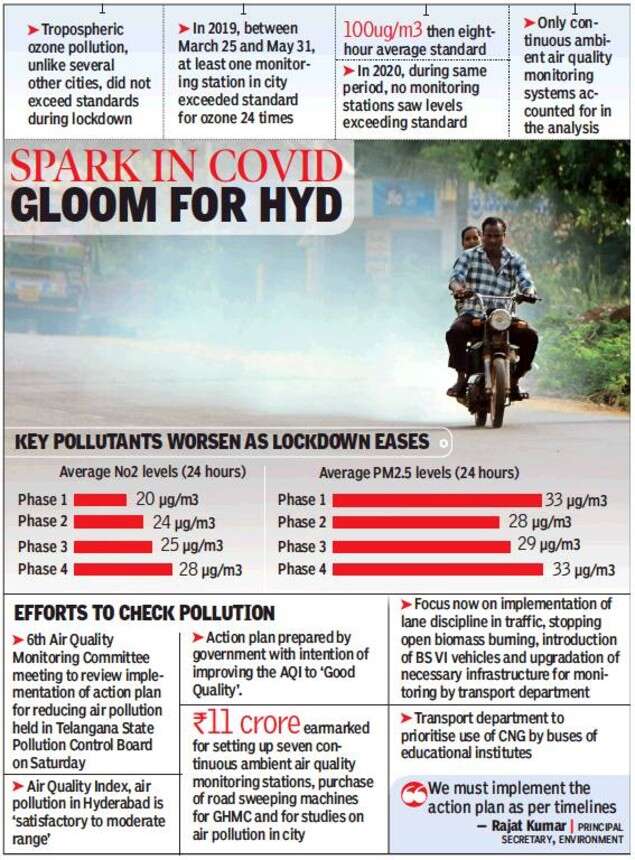
HYDERABAD: The city saw a rise in pollution levels during lockdown 4.0, when restrictions were relaxed, says a study by the Centre for Science and Environment (CSE), New Delhi.
In Hyderabad, the relaxation saw an over 40% increase in NO2 (Nitrogen dioxide) which is directly linked to vehicular traffic, the study says. The city was not far from Delhi, which saw an increase of 49%, Bengaluru (38%), and Ghaziabad (49%). However, it was not close to the cities which saw the highest increase such as Chennai (77%), Kochi (539%) or Visakhapatnam (89%).

Researchers from CSE said that during the lockdown, “Hourly NO2 curve was flattened in all cities daily, with morning peak almost disappearing and evening peak reducing by 22-90%.” They saw a similar reduction in PM2.5 (particulate matter 2.5) levels across cities during the lockdown. But in Hyderabad, the gains made in the middle of the lockdown for PM2.5 did not last as levels returned to those in the first phase.
While pollution levels in the city remained well within acceptable standards, researchers warned that increased traffic and industries could hamper gains, especially since worsening levels were being noticed. The analysis covered 22 mega and metropolitan cities in the country from the period of January 1, 2019 to May 31, 2020.
Speaking to TOI, Anumita Roychowdhury, ED-research and advocacy, CSE, said: “This pandemic has shown that a big reduction is possible only if all regions clean up together and at a scale and with speed across all critical sectors including vehicles, industry, power plants, waste, construction, use of solid fuels for cooking and episodic burning.” She suggested that for the post-pandemic period to sustain any gains made during the lockdown, it was important to reduce all pollutants.
In a surprise, the study noted that the lockdown was not the cleanest period for the city, with the previous monsoon being cleaner.
In Hyderabad, the relaxation saw an over 40% increase in NO2 (Nitrogen dioxide) which is directly linked to vehicular traffic, the study says. The city was not far from Delhi, which saw an increase of 49%, Bengaluru (38%), and Ghaziabad (49%). However, it was not close to the cities which saw the highest increase such as Chennai (77%), Kochi (539%) or Visakhapatnam (89%).

Researchers from CSE said that during the lockdown, “Hourly NO2 curve was flattened in all cities daily, with morning peak almost disappearing and evening peak reducing by 22-90%.” They saw a similar reduction in PM2.5 (particulate matter 2.5) levels across cities during the lockdown. But in Hyderabad, the gains made in the middle of the lockdown for PM2.5 did not last as levels returned to those in the first phase.
While pollution levels in the city remained well within acceptable standards, researchers warned that increased traffic and industries could hamper gains, especially since worsening levels were being noticed. The analysis covered 22 mega and metropolitan cities in the country from the period of January 1, 2019 to May 31, 2020.
Speaking to TOI, Anumita Roychowdhury, ED-research and advocacy, CSE, said: “This pandemic has shown that a big reduction is possible only if all regions clean up together and at a scale and with speed across all critical sectors including vehicles, industry, power plants, waste, construction, use of solid fuels for cooking and episodic burning.” She suggested that for the post-pandemic period to sustain any gains made during the lockdown, it was important to reduce all pollutants.
In a surprise, the study noted that the lockdown was not the cleanest period for the city, with the previous monsoon being cleaner.

Coronavirus outbreak
Trending Topics
LATEST VIDEOS
City
 On cam: VHP 'gau raksha' wing functionary shot dead in MP's Hoshangabad
On cam: VHP 'gau raksha' wing functionary shot dead in MP's Hoshangabad  Mangaluru boy writes exam with toes, Karnataka education minister appreciates
Mangaluru boy writes exam with toes, Karnataka education minister appreciates  Covid-19: Delhi following strategy of 'very aggressive' testing, says CM Arvind Kejriwal
Covid-19: Delhi following strategy of 'very aggressive' testing, says CM Arvind Kejriwal  Monsoon is here, covers India 12 days in advance, fastest since 2013
Monsoon is here, covers India 12 days in advance, fastest since 2013
More from TOI
Navbharat Times
Featured Today in Travel
Get the app





